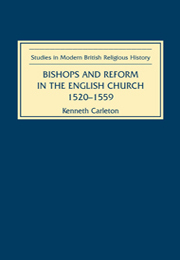Book contents
- Frontmatter
- Contents
- List of Illustrations
- Dedication
- List of Abbreviations
- Acknowledgements
- Introduction
- 1 Theologies of Episcopacy in mid-Tudor England
- 2 Models of Episcopal Office
- 3 Bishops of the English Church, 1520–1559
- 4 The Bishop and Preaching
- 5 Bishops and the Provision of Education
- 6 Prayer and Sacrifice: the Life of the Bishop
- 7 Episcopal Activity I: the Eradication of Heresy
- 8 Episcopal Activity II: the Propagation of the Ministry
- 9 Conclusion: the Old Episcopate in a New Order
- Appendix I Prosopography of the bishops in office, 1520–1559
- Appendix II The dioceses
- Appendix III The education of the bishops
- Appendix IV The bishops of Sodor and Man
- Bibliography
- Index of Scriptural References
- General Index
1 - Theologies of Episcopacy in mid-Tudor England
Published online by Cambridge University Press: 12 September 2012
- Frontmatter
- Contents
- List of Illustrations
- Dedication
- List of Abbreviations
- Acknowledgements
- Introduction
- 1 Theologies of Episcopacy in mid-Tudor England
- 2 Models of Episcopal Office
- 3 Bishops of the English Church, 1520–1559
- 4 The Bishop and Preaching
- 5 Bishops and the Provision of Education
- 6 Prayer and Sacrifice: the Life of the Bishop
- 7 Episcopal Activity I: the Eradication of Heresy
- 8 Episcopal Activity II: the Propagation of the Ministry
- 9 Conclusion: the Old Episcopate in a New Order
- Appendix I Prosopography of the bishops in office, 1520–1559
- Appendix II The dioceses
- Appendix III The education of the bishops
- Appendix IV The bishops of Sodor and Man
- Bibliography
- Index of Scriptural References
- General Index
Summary
Throughout the later Middle Ages the appointment of bishops to English sees took place as a result of mutual co-operation between the king and the pope. The fourteenth-century Statute of Provisors had rejected papal claims to appoint directly to bishoprics. The bishop was too important a figure in government to be left entirely to the nomination of the pope. The free election of bishops had been conceded to cathedral chapters by Henry I in the twelfth century, but with the king's effective veto of an unsuitable candidate the choice passed in practice largely into the hands of the Crown. The usual procedure was for the king to indicate his choice to the chapter by means of a congé d'elire, who would proceed with the election; the bishop-elect would then be recommended to the pope. In most cases, the pope accepted the royal candidate, and where the pope showed opposition to the choice, a compromise was reached; the pope then issued a bull of provision to the vacant see. A mutual understanding had been arrived at by the end of the fourteenth century that if the pope did not oppose the royal nominee, the king would not take exception to the bull of provision, except that the bishop, on doing homage to the king for grant of the temporalities of his see, was required to renounce those clauses in the bull which were seen to be prejudicial to the authority of the Crown. This procedure was invariably followed for the appointment of bishops for the English Church up to and including that of Thomas Cranmer as Archbishop of Canterbury.
- Type
- Chapter
- Information
- Bishops and Reform in the English Church, 1520–1559 , pp. 7 - 42Publisher: Boydell & BrewerPrint publication year: 2001



